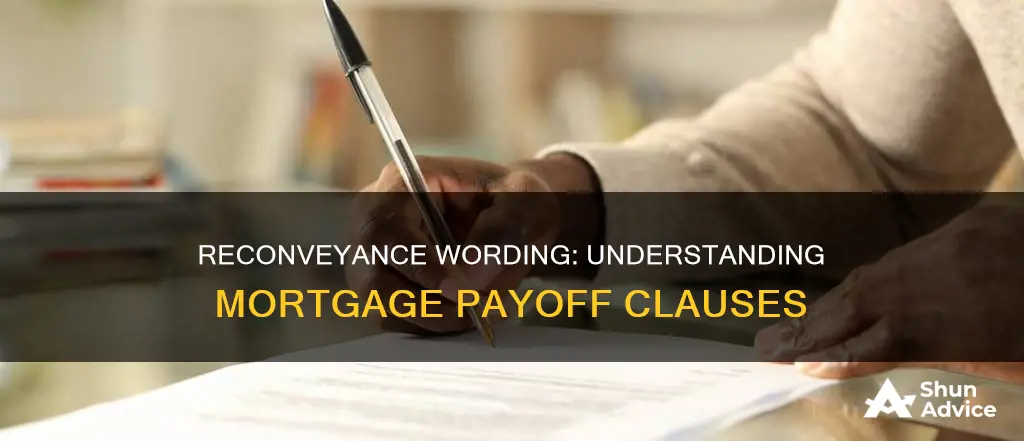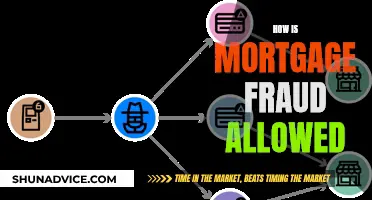
A deed of reconveyance is a document that proves a mortgage has been paid off in full and that the lender has acknowledged the full payment. It is a crucial step in the process of paying off a mortgage as it removes the lender's lien on the property's title and transfers ownership to the borrower. The deed of reconveyance is created by the lender and includes information such as the name and address of the homeowner, proof of full payment, and signatures from all parties involved. It is then submitted to the local recording office, such as the county clerk's office, to be officially recorded in public records. This step is essential to providing proof of ownership and ensuring a clear title for the property. Failure to properly record the deed of reconveyance can create issues when selling the home in the future.
| Characteristics | Values |
|---|---|
| What is a deed of reconveyance? | A document that proves a mortgage has been paid off in full and there is no longer a lien on the property held by a mortgage lender. |
| Who issues the deed of reconveyance? | The mortgage lender or trustee issues the deed of reconveyance. |
| Who receives the deed of reconveyance? | The borrower or homeowner receives the deed of reconveyance. |
| What happens if the deed of reconveyance is not recorded? | If the deed of reconveyance is not recorded, it creates a title issue. The deed of trust will remain a burden against the property, and the homeowner may experience difficulties when trying to sell the home. |
| What happens if the deed of reconveyance is recorded with errors? | If the deed of reconveyance is recorded with errors, it can also create a title issue. Records searches in the future may show the title as not clean. |
| What is the process of reconveyance? | The reconveyance process differs when a homeowner pays off their home loan with home sale proceeds versus paying off the loan directly with funds they have on hand. |
| What is the role of the settlement agent? | The settlement agent, a third party such as an attorney or escrow officer, handles the bulk of the reconveyance process. They run a title search to confirm whether any liens or title inconsistencies exist. |
| What is the role of the title company? | The title company handles the search and verification of title legitimacy and cleanliness. They then issue a title insurance policy for the lender while the mortgage is being paid and for the owner once the mortgage is fully paid and the title is transferred. |
| What is the role of the beneficiary? | If the trustee does not clear the title, the beneficiary must substitute itself in as trustee and execute a full reconveyance. |
What You'll Learn

The deed of reconveyance is issued when a mortgage is paid in full
A deed of reconveyance is a document that indicates that a mortgage has been paid in full. It is issued by the lender and confirms that the title of the property has been transferred from them to the borrower. The document is also known as a satisfaction of mortgage and is used to prove that the borrower has fulfilled their obligation to the lender.
The deed of reconveyance is a crucial step in the process of paying off a mortgage. Once the borrower has repaid the loan in full, the lender creates and issues the deed of reconveyance, which serves as proof that the borrower is now the legal owner of the property. This document is then submitted to the local recording office, such as the county courthouse, to be officially recorded. It is essential to carefully review the deed of reconveyance for any errors before submitting it, as inaccuracies can create title issues and delay or hinder the sale of the property in the future.
The deed of reconveyance typically includes the name and address of the homeowner, information proving that the mortgage loan has been paid off, and signatures from all parties involved, including a notary witness. It is important to note that the specific information included in the deed may vary depending on the state and locality.
In some cases, a deed of reconveyance may be issued when a homeowner refinances their existing loan with a new mortgage. This new mortgage effectively pays off the previous one, and the deed of reconveyance confirms that the original loan has been satisfied. However, it is important to note that this new mortgage creates a new security interest in the home for the lending institution.
Overall, the deed of reconveyance is a significant document that marks the end of a mortgage and ensures that the borrower has full ownership of the property, free and clear of any liens or claims from the lender.
Creating a Legal Mortgage: Understanding the Process and Requirements
You may want to see also

It transfers the title of the property to the borrower from the bank
A deed of reconveyance is a document that transfers the title of a property to the borrower from the bank or mortgage holder once a mortgage has been fully paid off. It is also known as a satisfaction of mortgage. The document is created and issued by the lender, and it is important to ensure that it is accurate and free of errors. The deed of reconveyance proves that the borrower has fulfilled their obligation to the lender and that the property now belongs to the borrower. It also shows that there are no outstanding claims or liens against the property, and the lender no longer has a security interest in the home.
The deed of reconveyance is a crucial step in the process of paying off a mortgage and transferring ownership. Once the borrower has paid back the loan in full, the lender needs to remove the lien on the property. The deed of reconveyance is then issued by the lender to the borrower, indicating that the mortgage loan has been satisfied and the borrower has full ownership of the property. This document is typically notarized and filed with the local recording office, such as the county courthouse or county clerk's office.
It is important to note that the specific process and requirements for a deed of reconveyance may vary from state to state and from lender to lender. For example, in some states, a satisfaction of mortgage document is used instead of a deed of reconveyance, but both serve the same purpose. Additionally, the information included in the deed of reconveyance can differ based on state and locality.
To ensure a smooth process, borrowers should carefully review the deed of reconveyance for any errors or inaccuracies before submitting it to the local recording office. It is also essential to confirm that the deed has been properly recorded to avoid any issues or delays in future property transactions. Working with a settlement agent or a title company can be helpful in navigating the reconveyance process and ensuring that all necessary steps are completed accurately.
Overall, the deed of reconveyance is a significant document that marks the end of a mortgage loan and the transfer of property ownership from the lender to the borrower. It is an important step in the process of paying off a mortgage and ensures that the borrower has clear and undisputed ownership of the property.
HECM Mortgage: Death of Owners, What's Next?
You may want to see also

It is a document that proves the loan has been paid in full
A deed of reconveyance is a document that proves that a loan has been paid in full. It is issued by the lender when a mortgage has been satisfied, and it transfers the title of a property to the borrower from the bank or mortgage holder. The deed of reconveyance confirms that the title has been transferred from the lender to the borrower, and the borrower now has full ownership of the property.
The deed of reconveyance is a legal document that indicates the transfer of a property's title and is recorded in the county where the property is located. It is important to ensure that the document is accurate and free of errors, as it will be kept and recorded by submitting it to the county registrar or records office. The deed of reconveyance is then filed in public records, providing proof of ownership of the property and that the loan has been repaid.
The process of reconveyance involves removing the lender's lien on the title of the property once the borrower has paid the loan in full. This is an essential step to cut ties with the lender and ensure that the mortgage is no longer a lien on the property. If the reconveyance is not completed and recorded, the mortgage will remain as a lien, impeding the transfer of the title to a buyer in the event of a sale.
The deed of reconveyance includes information such as the name and address of the homeowner, proof that the borrower has paid off the mortgage loan, and signatures from the parties involved, including a notary witness. It is worth noting that the information included in the deed of reconveyance can vary depending on the state and locality.
Paying Off My Mortgage: Strategies for Early Freedom
You may want to see also

It must be recorded in the local county or recorder's office
Once a mortgage loan has been paid in full, the lender issues a deed of reconveyance. This is a document that proves the borrower has fulfilled their obligation to the lender and that the property now belongs to them. It transfers the title of the property from the lender to the borrower. The deed of reconveyance must be recorded in the local county or recorders office. This is essential to providing proof of ownership of the property and that the loan has been repaid.
The deed of reconveyance must be recorded in the local county or recorders office, such as the county courthouse, as it is a legal transaction. The document must be notarized and filed in the public records. This is usually done by taking the deed to the county assessor's office. Recording the deed accurately is crucial, as any errors or failure to record it can create a title issue. This is known as a clouded title, where nothing shows the lien or encumbrance has been paid off. This can delay or jeopardize a future sale of the property.
A title search can be conducted to confirm whether any liens or title inconsistencies exist. This can be done by the settlement agent, or the homeowner can initiate their own title search by visiting the county's register of deeds or records office. It is important to ensure that the deed of reconveyance is recorded correctly, as it is the official action required to publicly declare the deed clear of any liens or debts. If the deed is not recorded or is recorded with errors, future records searches may show the title as not clean.
The process of recording the deed of reconveyance differs depending on whether the loan is paid off with home sale proceeds or directly with funds on hand. If the loan is paid off with home sale proceeds, the title company typically handles the recording. They will reach out to the lender and ask for a payoff statement, which reflects everything owed up to the day of closing. At closing, the title company will send the payoff to the lender and proof of payment to the buyer's lender. If the loan is paid off directly with funds on hand, the homeowner is responsible for providing the settlement agent with the mortgage information.
BPO Report Generation: Mortgage Process Simplified
You may want to see also

It is also known as a satisfaction of mortgage
A deed of reconveyance, also known as a satisfaction of mortgage, is a document that proves you’ve paid off your mortgage. It indicates that the mortgage loan is paid in full and shows that the borrower has the title and full ownership of the property. The deed of reconveyance is a document that indicates you’ve fully paid off the mortgage on your home. It represents the transfer of ownership from your mortgage lender to you.
Over the time you repaid your mortgage, you legally owned the property, but the lender held the mortgage lien, or claim, to it. Once you’ve paid back the loan, the lender needs to remove the lien. To do that, it’ll issue the deed of reconveyance. The deed of reconveyance proves that the lender no longer has a security interest in the home and the homeowner cannot be foreclosed upon by the lending institution. They can transfer the free and clear title of the property at any time.
The deed of reconveyance is completed and signed by the lender and filed with the local recording office, such as the county courthouse. The deed of reconveyance is issued after the borrower has paid off their mortgage in full. If you’re looking to sell your house, the deed of reconveyance shows that your property has a clear title, or that there are no outstanding claims or liens against the property.
A satisfaction of mortgage document will include the names of all parties associated with the mortgage. Other basic information will include the details of the mortgage loan and its payments, an acknowledgment that all payments have been made in full, details on the mortgage loan’s collateral property, provisions releasing the lender from a lien against the property, and the steps taken to transfer the property title.
Mortgage Pre-Approval: Essential Step for Home Loan Success
You may want to see also
Frequently asked questions
A deed of reconveyance is a document that proves that a mortgage has been paid in full. It indicates that the borrower has the title and full ownership of the property.
A deed of reconveyance includes the name and address of the homeowner, information that proves the borrower has paid off the mortgage loan, and lines for signatures from the involved parties, including a section for the notary witness.
If a deed of reconveyance is not recorded, it creates a title issue. The deed of trust will remain a burden against the property, and the homeowner may experience difficulties when trying to sell the home.
The reconveyance process differs when a homeowner pays off their home loan with sale proceeds or directly with their own funds. The settlement agent handles the bulk of the reconveyance process, including a title search to confirm whether any liens or inconsistencies exist.
A deed of trust is an agreement between a home buyer and a lender, stating that the home buyer will repay the loan and that the mortgage lender will hold the legal title to the property until the loan is fully paid. A deed of reconveyance is issued once the loan is paid in full and transfers the title of the property to the borrower.







